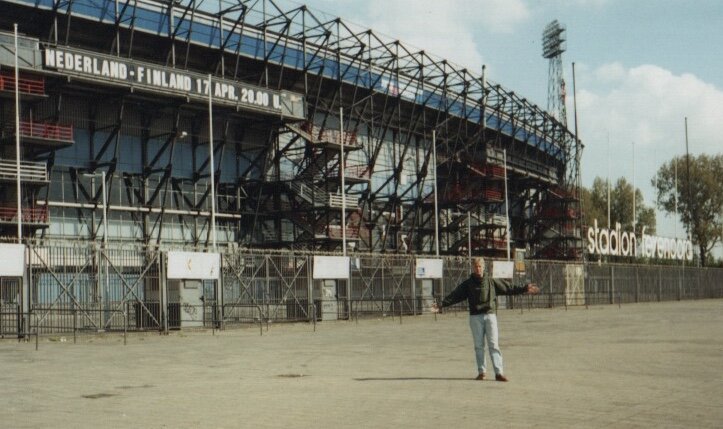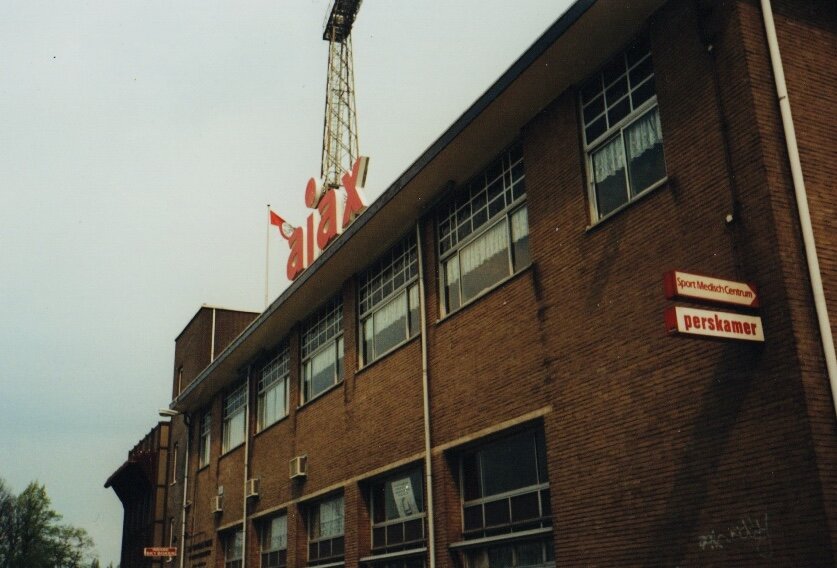I Invented the European Football Hop
He lived in an East End terrace and they were deceptively big houses. It took him an age to answer the telephone.
‘933 5921, who’s speaking please?’
‘Hello, Trevor.’ He recognised my Northern accent straight away. ‘Fancy going to Turkey next week?’
He’d been expecting my call.
‘Hang on a minute mate.’
He covered the mouthpiece with his hand and shouted to his wife, who was in another room.
‘Jane. Can I go to Turkey with Paul next week?’
‘How long you goin’ for?’ came the shrill reply.
He took his hand off the receiver.
‘How long we goin’ for?’
‘Three weeks.’ I conspired.
‘Three weeks..’ he bellowed back.
‘Yeah, alright then.’ and her voice trailed off resignedly.
Our challenge was to travel to Turkey and back within a three week time period, whilst taking in as many football matches as we could along the way.
Younger readers should take into account that there was no such thing as a budget airline in April 1991. There was no single European currency. We didn’t have Google Maps, in fact, we didn’t have to Google anything. We didn’t even have mobile phones!
The regulation rattler between Liverpool Lime Street and London Euston took just over four hours. Trevor was waiting for me on the platform, Monte Carlo Head Bag slung over the shoulder of his expensive leather coat.
I’d first met Trevor three years previous in Lausanne where Switzerland was playing England. We were the same age and we’d both been reared on an unhealthy diet of lower league football, he with Leyton Orient, me with Tranmere Rovers. The National team attracted many supporters from the Third and Fourth Divisions. Football fans who were eager to swap their weekly ration of meat and potato for something a bit more exotic. You’d regularly see lads from Stockport County, Carlisle United and Rochdale at England away games.
One of the Rochdale fans worked for British Rail and he did a roaring trade in knock-off Interrail tickets. So, with two of these in hand, a Rough Guide to Europe and Thomas Cook’s European Rail Timetable, we set off towards the Port of Harwich.
At Liverpool Street, I picked up a copy of Robert Maxwell’s broadsheet, The European. The front-page news was not good. War breaks out in Yugoslavia. The back pages, however, gave us vital information about the weekend’s football fixtures abroad.
The overnight North Sea crossing from Harwich to the Hook of Holland was moderate, good, occasionally poor.
We arrived in the Netherlands the next morning and headed straight for The Tub, or De Kuip, as the locals called it. There was no game at Feyenoord’s stadium, but city rivals, Sparta Rotterdam, were playing host to Bobby Robson’s PSV Eindhoven at Het Kassel and the 10 Guilder entrance fee was good value for money. Peter Houtman succeeded where Romário failed and the Dutchman’s solitary goal was enough to send a Spartan crowd home happy.
We weren’t going home however, we were going to Amsterdam to see Ajax play Heerenveen at Stadion De Meer, an arena that was hardly befitting of a three-time European Champion.
Again, the admission price was 10 Guilders and 18,000 supporters cheered the home side on to a 4.0 victory with goals from Willems, Kreek and a brace from Ajax’s 21-year-old centre forward, Dennis Bergkamp.
I listened to Bowie’s ‘Station to Station’ on my Walkman as we trudged across Paris on foot from Gare du Nord to Gare de Lyon. The few Francs we’d managed to save by not taking the Metro were spent on essential supplies for our overnight train journey to Turin.
Money was tight and financial constraints meant that tickets for Juventus’s European Cup Winners Cup tie against Barcelona at Stadio Delle Alpi were out of our price range.
We travelled 90 miles east to Milan, to watch Internazionale versus Sporting Lisbon in the UEFA Cup semi-final at the San Siro. Predictably, the Italians had ground out a goalless draw in the first leg, but in the return, an expectant 72,506 Tifosi were rewarded with goals from German duo, Lothar Mathäus and Jürgen Klinsmann, to put the tie beyond the reach of the Portuguese.
In Venice, we dined out on the 50,000 Lire that my father had given me with the instruction, ‘Get yourself a decent meal while you’re away.’
By the time we reached Vienna, we were back on our staple diet of freshly baked baguettes, cold Italian meats and that Tom & Jerry cheese with the holes in it. This would usually be accompanied by a litre bottle of Chateaux de Supermarket, but as I valued my eyesight, I took the initiative to swap the Austrian wine for Austrian bier. Halfway through its consumption and with no mind-altering effects forthcoming, we realised that I’d bought a case of non-alcoholic beer. It was the first time I’d seen Trevor angry and I’m happy to say, the last!
A giant Ferris wheel keeps a watchful eye over the Wiener Stadion. From there, we waltzed through the Prater amusement park to the U-Bahn station and caught a rapid train to a Rapid training session at the Gerhard Hanappi Stadion. Rapid Vienna’s coach, Hans Krankl, came over to have a chat with us. In 1978/79, Krankl was the top scorer in Spain’s La Liga, with 29 goals for Barcelona. He is widely regarded as one of Austria’s greatest ever players.
The following day, we paid 570 Schilling to watch Krankl’s team take on Admira Wacker at the Bundesstadion Südstadt. There were only 2,300 fans at the game, but it was a lively encounter, finishing 2.2, with goals from Gretshnig, Anfalterer, Kienast and Keglevits.
Overnight accommodation was proving to be more costly than sleeping on the trains. The advantage of staying in hotels, however, was the promise of a hot shower in the morning.
With a long journey ahead of us, we felt the need for a deep clean, so we bought couchette class tickets to Munich and bathed in the swimming pool where Mark Spitz had won his seven gold medals at the ‘72 Olympics.
The entrance fee to the Olympiapark was 1 Deutschmark and after our swim, we ambled around the Olympiastadion where West Germany had beaten Holland in the 1974 World Cup Final.
Our Trans-Europe Express from München Hauptbahnhof took thirty-seven hours. We shared our compartment with an elderly, shortsighted Texan who was retracing a rail journey he’d made fifty years before. As the Americans would say, ‘Do the Math.’
From Germany, we backtracked across Austria, and on through warring Yugoslavia, Bulgaria and eventually into Istanbul.
Refreshed after a cut-throat shave and a Byzantine bath, we visited the Grand Bazaar and the Blue Mosque before boarding a bus full of chain-smoking Turks headed toward the Aegean port of Izmir.
The European Championship Group 7 qualifier between Turkey and England on the 1st of May 1991 was the reason we’d travelled all the way to Izmir. Two hours safe haven in the Atatürk Stadi cost 20,000 Lire and we considered ourselves lucky that only 25,000 bloodthirsty Turks had turned out to try and kill us! Our survival chances weren’t helped by a Dennis Wise scrambled winner in the 32nd minute.
Somehow we escaped bloodshed and Izmir to the beautiful seaside resort of Kusadasi where we embarked on a bit of island hopping before eventually reaching the Greek mainland.
Oozing with Corinthian spirit, we cut across the country from Piraeus to Patras and joined a ferry boat bound for Italy. Having visited industrial Turin, majestic Milan and palatial Venice, it was evident where Italy’s wealth lay and it wasn’t in the south. Brindisi was a city that was quite literally, down at heel.
‘Say what you like about Mussolini, at least he made the trains run on time.’ Trevor quoted, as the sleeper pulled into the capital’s Stazione Termini. Rome wasn’t built in a day and we certainly weren’t going to see it in one, so we headed north in search of a leaning tower and a Serie A football match.
7,931 Italian football fans huddled under a phalanx of umbrellas at the Arena Garibaldi for Pisa’s home game against Lazio. Ruben Sosa produced the afternoon’s only ray of sunshine when the little Uruguayan scored the only goal of the game to secure all three points for the visitors.
Weatherworn and weary, we zipped up the front of Italy’s boot into the snowy Alps. We’d travelled through eleven countries, visited eleven stadia and watched six football matches. It was time to go home. We took the TGV from Geneva to Paris and a cross channel ferry from Boulogne to Dover. Never had a full cooked English breakfast tasted so good. We went our separate ways at Waterloo and Trevor promised to send me a duplicate set of photographs once he’d had the film developed.
As the InterCity 125 pulled into Liverpool Lime Street, I wondered, how many great football journeys had started and finished at this iconic station. Liverpool fans venturing to Rome in ‘77, Everton supporters returning triumphantly from Rotterdam in ‘85. But these were one-off European finals, not Hops, right?
Trevor and I had been to the European Championships in West Germany and the World Cup in Italy, but can these international soccer tournaments realistically be considered Football Hops? No, I invented the European Football Hop and E-Hop #1 had set the benchmark for all future football hops. Hadn’t it?




